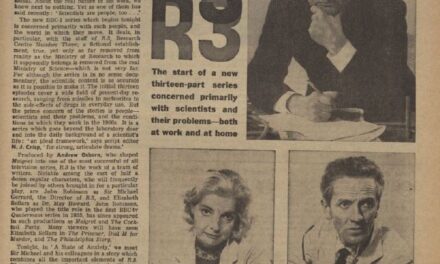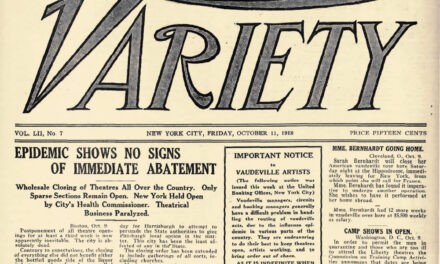Last September, an interesting debate played out in the landscape of American media criticism. It was catalysed by film critic A.O. Scott’s article in the New York Times entitled ‘The Death of Adulthood in American Culture’. The piece is a meandering contemplation about the changing nature of American popular media, and its core argument revolves around what Scott sees as the demise of grown-up culture at the expense of, and simultaneous replacement with, juvenile entertainment; a phenomenon permeating both film and TV. Importantly, Scott attempts to support this observation by threading into it another, similar polarity in popular culture between the apparent slow ‘death’ of patriarchy on the one hand – a process dramatized by a certain strand of television, specifically by cable TV’s Holy Trinity of Mad Men (2007-), Breaking Bad (2008-2013), and The Sopranos (1999-2007) –, and the rise of a newly invigorated ‘feminist’ sensibility on the other. While this think piece has been thoroughly analysed, celebrated, and refuted on prominent online media sites like Vulture.com, Salon.com or the Huffington Post, I want to consider its significance for the ongoing debates in television studies about the cultural hierarchies between film and TV, and particularly the underlying gendered connotations of this discourse.
This seems all the more timely to me since, although the article’s impact might have run its course online, it was picked up once more in the January 2015 issue of Sight and Sound, a turn which in itself shows the increasing importance of the ‘cinema versus TV’ debate for prestige film criticism. To wit, not only did the issue’s end-of-year poll of best UK releases now enable critics to vote for their favourite TV series beside films; but the articles accompanying the poll emphasise that it is acceptable (for critics and for viewers) to consider some television as worth discussing in terms of aesthetic significance, or for the way it signifies the changes taking place in both industries. The short think piece in which Scott’s article is cited as an influence laments the ‘eclipse of what we think of as adult themes’ and a growing ‘attachment to childhood’ in Hollywood cinema (comic book franchises, YA and fantasy fiction adaptations, animations etc.) and in some independent films (Romney 2015). Moreover, Nick James’ introduction to the poll claims that ‘TV is where the adult viewing experience and much of the best writing and directorial talent now lie’, and thus ‘you get the sense that the reciprocal prejudices and snobberies between cinema and television drama are beginning to fall away’ (James 2015).
The themes that are being picked up here by the elite of Anglo-American film criticism are surely nothing new for media scholars: with the emergence of the phenomenon of American ‘quality’ television (but to an extent even before that), the scrutiny of the symbiotic relationship between the two media and their problematic hierarchical evaluation has become a small but important strand in media research. There is a range of scholarship unpacking the ways in which the notion of cultural value for fictional TV is discursively defined as emulating the cinematic, while also tacitly continuing to utilise the TV format’s own traditional methods of storytelling and aesthetics. (Brett Mills’ recent blog post here on CST tackles the same issue from the perspective of film broadcasting on British TV.)
What I have found most curious about Scott’s piece and the Sight and Sound poll was how the writers use this apparent dualism of TV and cinema to extend it with further meanings in an effort to help them get a grasp of the popularity of the adolescent entertainment that gives them such palpable anxiety. The now explicitly gendered framing of that discussion is clear: Scott claims that the archetypal patriarch’s ‘gradual slide toward obsolescence’ is being carved into cultural consciousness exclusively on television – in a tiny, but all the more important, corner of it –, which is also the primary platform where a ‘new cultural feminism’ (in his term) is becoming dominant through female-centred programmes that evade straightforward generic classifications (with Sex and the City [1998-2004] being the flag bearer of that trend). Thus, he explains this presumed phenomenon as a kind of cultural revolution whereby the old-fashioned, angsty, highbrow dramas about ageing antiheroes are being pushed off the scene by an ideal of perpetually young or at least immature subjectivity, manifested in the hybridised forms of female-dominated half-hour comedy and dramedy. The increasing dominance of adolescent culture that Scott and Sight and Sound’s film critics lament is then meshed together with a supposed feminisation of this culture, an observation that also articulates specific boundaries of the forms and genres in which this takes place. Consider James’ assertion (quoted above) that in the slow melting away of ‘reciprocal snobberies’ between film and TV (a phrasing that some TV scholars might have a bone to pick with, at least with the ‘reciprocal’ part), the last resort of mature, i.e. analysis-worthy cultural entertainment, is television drama, a form where, as Scott asserts, the fall of old-fashioned masculinity is being gloomily captured. While not engaging with Scott’s central argument about gender politics, Romney’s piece puts the relevance of youth culture for a grown-up viewing experience firmly in its place: ‘recent US cinema (…) tends to treat childish matters as if they were of quasi-adult importance, and to make adult matters seem trivial, even while ostensibly taking them seriously’ (ibid.). What these accounts implicitly betray in their critical diagnosis is the unquestioning acceptance of equating certain forms of entertainment with a lack of seriousness, immaturity, feminisation, and, following from all this, an inconsequential triviality.
The discourses and associations expressed here are far from new, but rarely have they been articulated so explicitly in one breath. For instance, into the whole ‘No Country for Old Men’ versus ‘Young Feminists’ dualism, we find inscribed the discourse of generational conflict as a staple of feminist debate; or it would be more precise to say that it is a staple of the media discourse about feminism which associates women’s empowerment with the cultivation of youth and beauty (as argued by analysts of postfeminism). The difference is that the opponents here are not out-of-touch second wavers versus young third wavers/postfeminists/etc.; for Scott, all these parties are rhetorically united in their eternal youthfulness or rather, immaturity – pushing the old patriarch off his throne. The generational conflict of feminism is thus turned into one between the genders (and looming behind this image is the trope of the man-hating feminist).
Because this dualism is also entangled with a binary between mature versus immature culture, it can also be considered from the perspective of the values ascribed to these notions. Considerations of genre theory about the hierarchies between ‘serious’ (i.e. grown-up) and ‘non-serious’ (i.e. immature) modes of fiction are useful here. As Mills argues, because Western culture cultivates seriousness as the primary mode of communication, it also normalizes it as inherently more valuable than all others (Mills 2005). Hence, these film critics are dismayed about the pervasiveness of adolescent culture which for them entails the destruction of ‘serious’ communication. When Scott notes that the ‘new cultural feminism’ takes place in TV’s hybridised forms of half-hour dramedy and comedy, he draws on such associations to make his claim that these genres valorise insincerity; and this thinking helps him make the leap of logic in which the female-centred dramedies do the same cultural work as, say, the comic book film or the fantasy franchise. All of these forms provide ‘infantile’ pleasures for their viewers, out to destroy the grown-up seriousness of pure tragedy and drama.
While such elitist hierarchies are fairly fixed staples of cultural criticism, what is new in these laments is the role that TV plays for the critics on this imaginary cultural battlefield. In the post-network era, popular TV criticism has operated in a tacit or overt agreement that the medium is making efforts to ‘grow up’ to the more sincere and aesthetically superior cinema, while TV scholarship preserved its foundational interest in studying the medium for its political significance (which at its beginnings entailed a gesture of active resistance to the cultural disdain levelled at TV). But Scott’s and Sight and Sound’s critical texts now signal a changing of these tides in that leading voices in the field of film criticism declare a small pocket of fictional TV as one of the last bastions where ‘grown-up’ cinematic aestheticism still dominates – outperforming not just its own medium, i.e. ‘regular’ TV, but cinema itself. As such, the shift in the apparent cultural status of the two media is connected to the ways in which the modes of communication ascribed to them are being slowly ‘swapped’. This reveals that these modes – and their associated values – retain their existing positions in cultural consciousness. A closer look at the Sight and Sound poll’s TV votes provides an example for this. The series most frequently mentioned as critics’ favourite is Bruno Dumont’s P’tit Quinquin (2014), a French four-part miniseries that was also distributed in cinemas as one 200-minute feature film last year and in critical reception discussed for its merits as auteur cinema (Cahiers Du Cinema chose it for its best film of 2014 – a definite first for a TV programme). As for its position in the landscape of quality television, a voter sums it up thus: ‘There’s no question that this work for television will endure as one of [Dumont’s] greatest films’ (Sight and Sound: 45). For these critics, it is no longer the case that television emulates cinema. Rather, television replaces cinema in producing ‘cinematic’ content. Runners-up in the poll are True Detective (2014-) and The Knick (2014-), both similarly praised by critics in terms of cinematic aesthetics and authorship discourse. It is perhaps also worth noting that Transparent (2014-) and Orange Is the New Black (2013-) are both mentioned once in the poll (by Sophie Mayer and Catherine Wheatley respectively), and here the voters justify their choice not for the programmes’ artistic achievements but for what they see as their political progression. Further, Wheatley’s evaluation is formulated as a defiant stand against the assumed popularity of True Detective among critics, to which she prefers the ‘diverse portfolio of women’s experiences’ (Sight and Sound: 48). Here it becomes quite clear that the boundaries that these film critics’ evaluations of television draw – between formats, genres, and programmes – are implicitly or explicitly gendered. Considered together with Scott’s article, feeding into this gendering is the critical concern over the threat of popular culture’s infantilisation. Those ‘reciprocal prejudices’ that James sees as ‘beginning to fall away’ between TV and film continue to exist on different platforms in newly expressed hierarchies.
The cultural anxieties that these critics express about the changing nature of popular entertainment, then, reveal the fixedness of the ideologies behind their value judgements. In these assessments, such ideologies remain unexamined; hence, for instance, the unquestioning equation of the dramatic form and authorship discourse with high(er) artistic quality, superior ‘meaning’, and a maturity which can only be articulated in contrast with lesser forms of entertainment. The signification by which adolescent culture becomes associated with infantile pleasures also infantilizes the viewer whose consumption and fan practices bring all culture down to its own childish level (Scott speaks of how the ‘unassailable ascendancy of the fan has made children of us all’). The ways these new binaries are constructed bring to mind Lynn Joyrich’s study of the critical struggles over network era television’s cultural role (Joyrich 1996). She argues that leading cultural critics’ anxiety about postmodern society was expressed in terms that tacitly understood the consumer culture of late capitalism as emasculating, a process in which ‘new anxieties are created which are then often projected onto television’ (ibid. 74). Investigating the logic of these accounts, she finds that the binary categories which postmodernity has for its analysts eradicated have only shifted places, and still regulate cultural hierarchies. In the mid-1990s when this was written, television obviously occupied the ‘inferior’ position, and it did so on profoundly gendered terms: ‘(…) constructing a duality in which television is placed in opposition to some other, more “respected” medium, these critics and theorists articulate cultural and textual differences in terms that are reminiscent of what is still posed as the dominant binary of our culture – sexual difference’ (ibid. 72). Crucially, Joyrich also links this gendered motif to discourses about the immaturity of feminised consumerist culture: ‘(…) the forms that have been cited by both defenders and detractors as particularly illustrative of U.S. television also exhibit a consumerism tied to an address to an audience deemed infantile or feminine, a spectator not fully a man’ (ibid. 78). Joyrich’s analysis remains eerily relevant for understanding the contemporary anxieties of leading film critics like Scott and Sight and Sound’s contributors; lurking behind the struggles to denote ‘quality’ TV drama as the Land of Lost Art is the tiny hope that by watching it we can just a little longer remain fully a man.
Julia Havas gained MAs in Film Studies and German Studies in Hungary, and is currently a PhD candidate at the University of East Anglia. Her research investigates the ways in which feminism is represented on contemporary American ‘quality’ TV by looking at four female-centred series as case studies.





